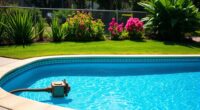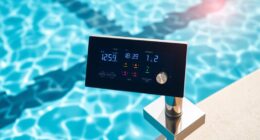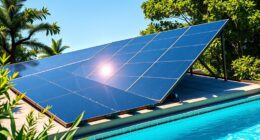Rooftop infinity pools combine stunning aesthetics with complex engineering. Architects wish you knew how they must carefully plan for structural support, waterproofing, and leak prevention to guarantee safety and longevity. Integrating the edge seamlessly with architecture, managing water circulation, and using hidden systems are essential for a sleek look. Sustainability and environmental factors also play a big role. To uncover the secrets behind these impressive designs, keep exploring how experts make it all work seamlessly.
Key Takeaways
- Proper structural support and waterproofing are critical to prevent leaks, structural failure, and water damage in rooftop infinity pools.
- Concealing technical systems like filtration and hydraulic components maintains aesthetic appeal and seamless operation.
- Material selection must match building surfaces for durability, weather resistance, and visual harmony.
- Safety features such as barriers and lighting are essential to prevent accidents and enhance nighttime ambiance.
- Efficient water circulation, filtration, and environmental controls ensure water clarity, sustainability, and long-term pool integrity.
The Structural Engineering Challenges of Rooftop Infinity Pools
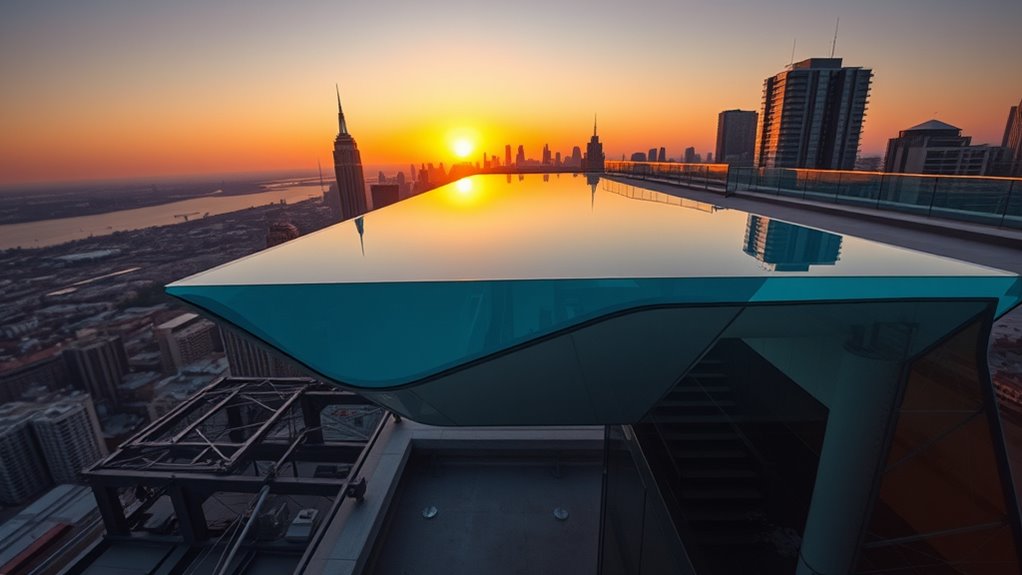
Building a rooftop infinity pool presents significant structural engineering challenges because the weight of the water and the pool itself exerts immense pressure on the building’s foundation. To manage this, you need robust support systems, often involving advanced hydraulic systems that distribute weight evenly and prevent stress points. Proper integration of these systems ensures the pool remains stable under fluctuating loads. Equally important is aesthetic integration—designing the pool so it seamlessly blends with the building’s architecture without compromising safety. This involves careful planning of materials and structural elements to support both form and function. You must also consider water retention, waterproofing, and load-bearing capacity to prevent structural failure, all while maintaining a sleek, visually appealing design. Additionally, understanding structural support systems is crucial for ensuring the long-term stability of rooftop infinity pools.
Ensuring Safety and Stability in High-Rise Installations
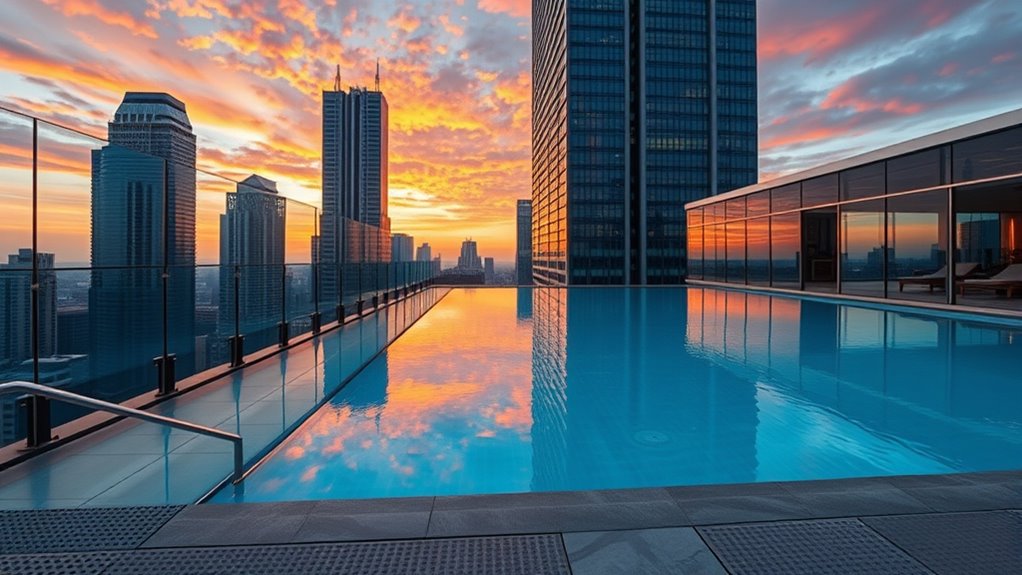
To guarantee safety and stability in high-rise rooftop infinity pools, you must implement rigorous engineering practices and meticulous design strategies. Prioritize structural integrity to support the pool’s weight and dynamic loads. Incorporate safety features like edge barriers and clear signage to protect guest safety. Assure maintenance access is thoughtfully integrated for easy inspections and repairs without compromising stability. Use high-quality materials resistant to weather and corrosion, reducing risks over time. Regularly monitor load distribution and structural performance to prevent failures. Maintain extensive safety protocols for emergency situations. Collaborate with specialists to validate design and construction standards. These steps help create a secure environment where guests can enjoy the pool safely, knowing that stability and maintenance concerns are proactively managed. Incorporating expert voice actors in your safety and instructional signage can also enhance clarity and compliance.
The Importance of Waterproofing and Leak Prevention
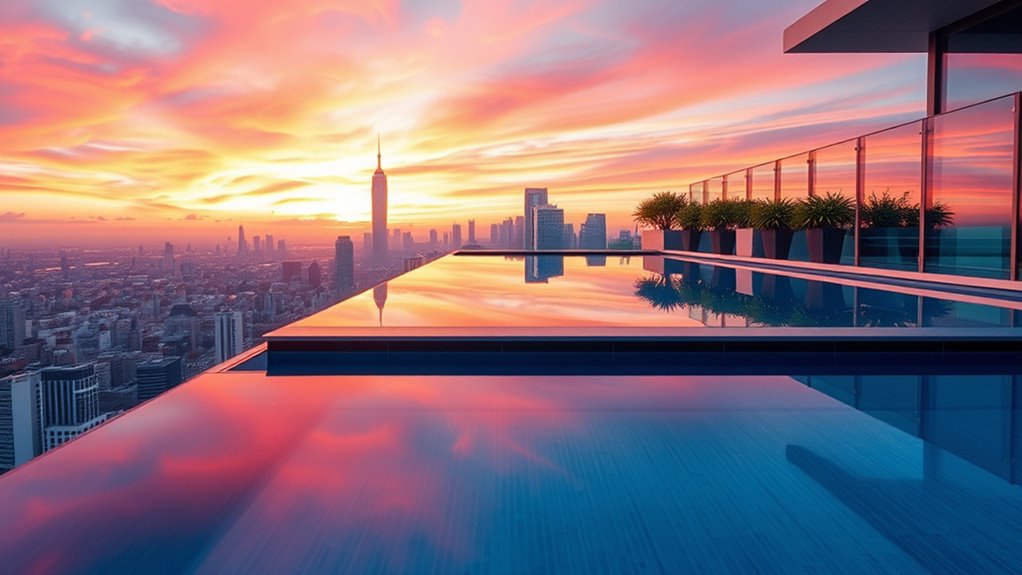
Waterproofing and leak prevention are critical for maintaining the integrity and safety of rooftop infinity pools. Proper waterproofing guarantees water stays contained, preventing structural damage and costly repairs. It also helps maintain thermal insulation, keeping water warm and reducing energy costs. Leak prevention minimizes water loss, protects surrounding structures, and preserves acoustic dampening, reducing noise transfer. Consider durable membrane systems and sealants tested for high-rise environments. Additionally, selecting waterproof membrane systems that are compatible with high-rise applications is essential for long-term durability. Here’s a quick overview:
| Aspect | Importance | Key Features |
|---|---|---|
| Waterproofing | Prevents leaks, structural damage | Flexible, UV-resistant materials |
| Leak Prevention | Saves water, reduces repair costs | Precise sealing techniques |
| Thermal Insulation | Maintains water temperature | Insulation layers integrated |
| Acoustic Dampening | Minimizes noise transfer | Soundproofing barriers |
Integrating Infinity Edges Seamlessly With Architecture
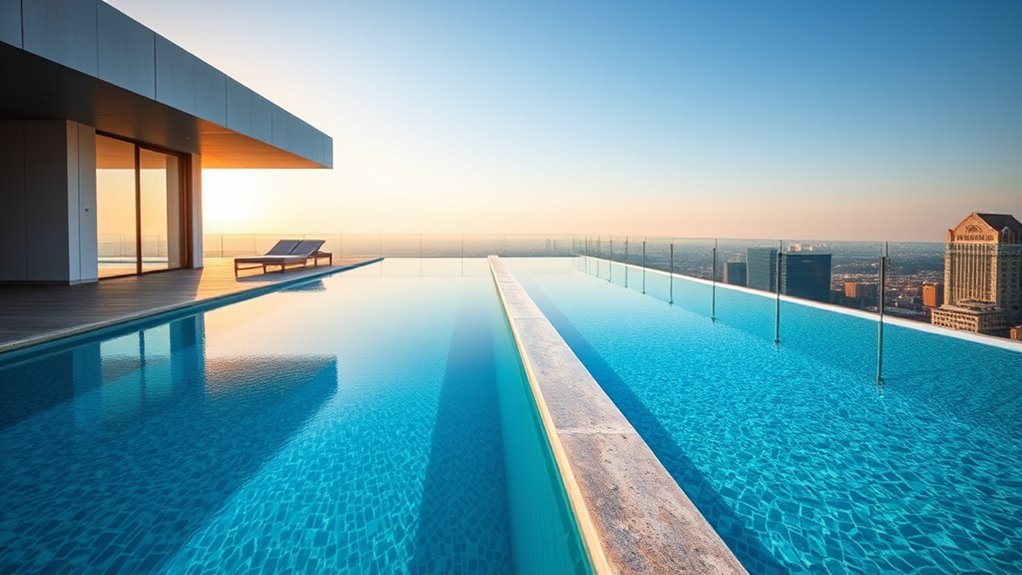
Seamlessly integrating infinity edges with the surrounding architecture requires careful planning and precise execution. Your goal is to create a visual flow that blurs the boundary between water and sky. Focus on material selection to guarantee the edge blends smoothly with building surfaces and architectural details. Proper design enhances visual integration, making the pool appear as an extension of the structure. To achieve this, consider these:
- Choose materials that match or complement the building’s façade
- Use thin, transparent edges for a cleaner visual line
- Incorporate lighting to emphasize the infinity edge at night
- Coordinate the pool’s elevation with architectural elements
- Ensure structural elements support seamless integration
- Consider the environmental impact of materials and design choices to promote sustainability in your project.
Attention to detail in material selection and design ensures your rooftop infinity pool complements the architecture beautifully.
Water Circulation and Filtration Systems for Large-Scale Pools
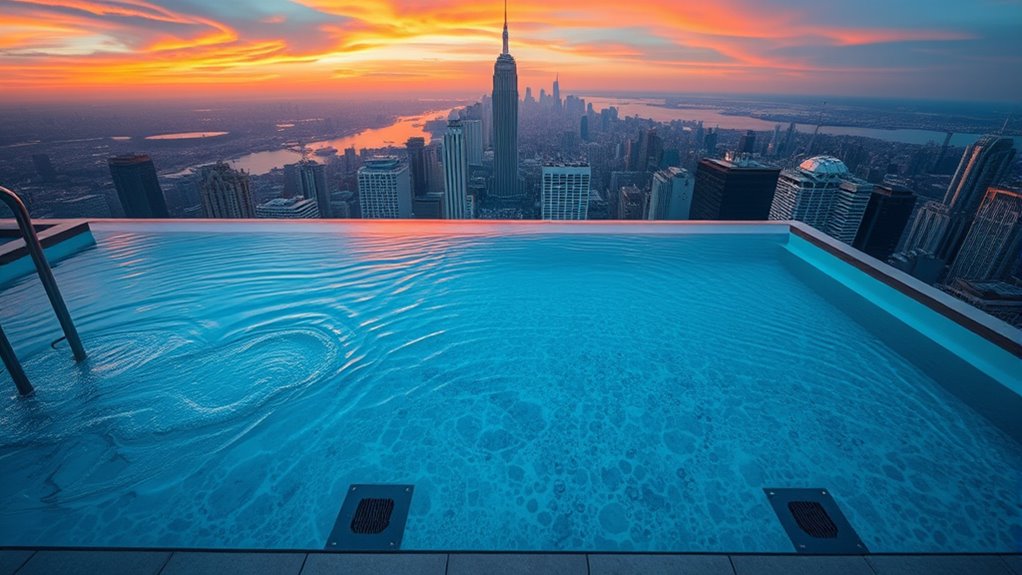
Achieving a stunning rooftop infinity pool not only depends on design and materials but also hinges on effective water circulation and filtration systems that keep the water pristine and inviting. You need systems that balance aesthetics with functionality, ensuring the pool looks flawless from every angle. Modern circulation pumps and filtration units are designed to operate quietly and efficiently, reducing energy consumption without sacrificing performance. Proper placement and integration of these systems prevent water stagnation and algae growth, maintaining clarity and safety. By prioritizing energy efficiency, you lower long-term operating costs and environmental impact. An ideal setup ensures your infinity edge functions flawlessly, creating that seamless visual effect while keeping maintenance manageable. Incorporating automatic filtration can further enhance water quality by continuously removing debris and contaminants, ensuring crystal-clear water at all times. Ultimately, well-designed circulation and filtration systems are key to a beautiful, sustainable rooftop infinity pool.
Sustainability and Environmental Considerations

As you design a rooftop infinity pool, prioritizing sustainability and environmental considerations is essential to minimize your ecological footprint. Incorporate green building principles by selecting eco-friendly materials that reduce environmental impact. Use energy-efficient systems for heating, lighting, and circulation to conserve resources. Opt for recycled and locally sourced materials whenever possible, supporting sustainable construction. Consider installing solar panels to power pool functions and reduce reliance on non-renewable energy. Implement water-saving features like cover systems and greywater reuse to minimize waste. Additionally, choose non-toxic, biodegradable finishes and low-VOC paints to improve indoor air quality. Exploring for sale 100 options for eco-friendly pool accessories can further enhance sustainability. By integrating these practices, you’ll create a stunning, environmentally responsible luxury space that aligns with modern green building standards.
The Hidden Work Behind Aesthetic and Functional Design
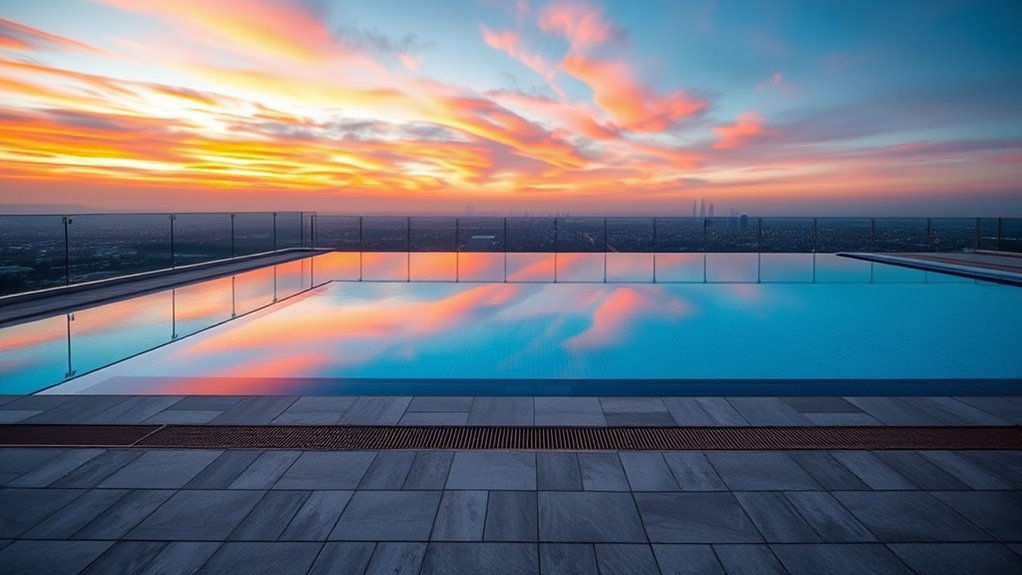
Designing a rooftop infinity pool involves more than just selecting luxury materials and installing advanced systems; it requires meticulous attention to the unseen work that guarantees both aesthetic appeal and functionality. You might see stunning visuals, but behind the scenes, engineers ensure structural integrity and proper drainage. Lighting design plays a vital role, creating ambiance and safety after sunset.
| Element | Purpose |
|---|---|
| Luxury materials | Enhance visual appeal, durability, and comfort |
| Structural support | Maintain safety and withstand environmental stress |
| Lighting design | Set mood, improve safety, highlight features |
| Water circulation | Ensure clean, balanced water for visual clarity |
| Hidden systems | Manage drainage, heating, and filtration seamlessly |
Frequently Asked Questions
How Do Architects Address Wind Load Challenges on Rooftop Pools?
Architects address wind load challenges on rooftop pools by designing for wind resistance and incorporating structural reinforcement. They analyze local wind conditions and use advanced modeling to guarantee stability. Reinforcing the structural framework with stronger materials and strategic bracing helps prevent movement or damage. You should trust that these measures keep your rooftop pool safe and secure, even in strong winds, while maintaining its aesthetic appeal.
What Are the Cost Differences Between Rooftop and Ground-Level Infinity Pools?
Imagine gazing over a cityscape from a rooftop infinity pool, feeling the thrill of luxury. You’ll find that rooftop pools usually cost more than ground-level ones due to complex pool construction and specialized material selection to withstand weight and environmental stresses. The elevated location demands stronger structural support, which increases expenses. Ground-level pools are simpler, making them more affordable, but rooftop pools deliver that breathtaking view and exclusivity that’s worth the extra investment.
How Do Rooftop Pools Impact Building Energy Efficiency?
Rooftop pools can impact your building’s energy efficiency by increasing thermal insulation, which helps retain heat during cold weather and keeps the building cooler in summer. However, they may also raise water consumption, affecting water conservation efforts. Proper insulation and efficient filtration systems are essential to minimize energy use and reduce environmental impact, ensuring your rooftop pool enhances sustainability rather than hindering it.
Are There Specific Zoning or Building Codes for Rooftop Infinity Pools?
You should know that zoning restrictions and safety regulations do set some guidelines for rooftop infinity pools. Local codes often specify setbacks, load limits, and safety barriers to guarantee your pool’s safe and compliant. It’s wise to consult with local authorities or professionals early, as these rules can vary widely. Staying informed helps you enjoy your stunning pool while respecting the building’s safety standards and zoning requirements.
What Maintenance Challenges Are Unique to Rooftop Infinity Pools?
You’ll face unique maintenance challenges with rooftop infinity pools, like ensuring proper pool waterproofing to prevent leaks that can damage the building. Regularly check the structural reinforcement, as the weight and exposure can weaken the structure over time. Keep the filtration system in top shape and monitor for debris. These proactive steps help maintain the pool’s integrity and safety, ensuring your stunning rooftop oasis stays beautiful and functional.
Conclusion
Building a rooftop infinity pool is like crafting a delicate bridge between sky and water—you hold its beauty in your hands, but it must be supported by careful engineering and unwavering care. When you understand the challenges behind the scenes, you appreciate the breathtaking vista even more. Remember, every shimmering edge and seamless flow reflects not just design, but your commitment to safety, innovation, and sustainability—turning a dream into a stunning reality that stands tall and true.

